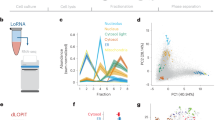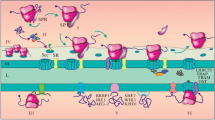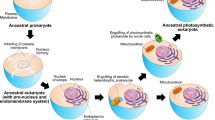Summary
All eukaryotic cells display a dramatic partitioning of mRNAs between the cytosol and endoplasmic reticulum (ER) compartments—mRNAs encoding secretory and integral membrane proteins are highly enriched on ER-bound ribosomes and mRNAs encoding cytoplasmic/nucleoplasmic proteins are enriched on cytosolic ribosomes. In current views, this partitioning phenomenon occurs through positive selection—mRNAs encoding signal sequence-bearing proteins are directed into the signal recognition particle pathway early in translation and trafficked as mRNA/ribosome/nascent polypeptide chain complexes to the ER. In the absence of an encoded signal sequence, mRNAs undergo continued translation on cytosolic ribosomes. Recent genome-wide analyses of mRNA partitioning between the cytosol and the ER compartments have identified subsets of mRNAs that are non-canonically partitioned to the ER—although lacking an encoded signal sequence, they are translated on ER-bound ribosomes. These findings suggest that multiple, and as yet unidentified, pathways exist for directing mRNA partitioning in the cell. In this contribution, we briefly review the literature describing the subcellular partitioning patterns of mRNAs and present a detailed methodology for studying this fundamental, yet poorly understood process.
Access this chapter
Tax calculation will be finalised at checkout
Purchases are for personal use only
Similar content being viewed by others
References
Palade, G. (1975) Intracellular aspects of the process of protein synthesis. Science 189(4200): p. 347–358.
Blobel, G. and B. Dobberstein (1975) Transfer of proteins across membranes. I. Presence of proteolytically processed and unprocessed nascent immunoglobulin light chains on membrane-bound ribosomes of murine myeloma. J Cell Biol 67(3): p. 835–851.
Blobel, G. and B. Dobberstein (1975) Transfer of proteins across membranes. II. Reconstitution of functional rough microsomes from heterologous components. J Cell Biol 67(3): p. 852–862.
Blobel, G., et al. (1979) Translocation of proteins across membranes: the signal hypothesis and beyond. Symp Soc Exp Biol 33: p. 9–36.
Lingappa, V.R. and G. Blobel (1980) Early events in the biosynthesis of secretory and membrane proteins: the signal hypothesis. Recent Prog Horm Res 36: p. 451–475.
Gilmore, R. and G. Blobel (1983) Transient involvement of signal recognition particle and its receptor in the microsomal membrane prior to protein translocation. Cell 35(3 Pt 2): p. 677–685.
Walter, P., I. Ibrahimi, and G. Blobel (1981) Translocation of proteins across the endoplasmic reticulum. I. Signal recognition protein (SRP) binds to in-vitro-assembled polysomes synthesizing secretory protein. J Cell Biol 91(2): p. 545–550.
Walter, P. and A.E. Johnson (1994) Signal sequence recognition and protein targeting to the endoplasmic reticulum membrane. Annu Rev Cell Biol 10: p. 87–119.
Nicchitta, C.V., et al. (2005) Pathways for compartmentalizing protein synthesis in eukaryotic cells: the template-partitioning model. Biochem Cell Biol 83(6): p. 687–695.
Mechler, B. and T.H. Rabbitts (1981) Membrane-bound ribosomes of myeloma cells. IV. mRNA complexity of free and membrane-bound polysomes. J Cell Biol 88(1): p. 29–36.
Mueckler, M.M. and H.C. Pitot (1981) Structure and function of rat liver polysome populations. I. Complexity, frequency distribution, and degree of uniqueness of free and membrane-bound polysomal polyadenylate-containing RNA populations. J Cell Biol 90(2): p. 495–506.
Diehn, M., et al. (2000) Large-scale identification of secreted and membrane-associated gene products using DNA microarrays. Nat Genet 25(1): p. 58–62.
Lerner, R.S., et al. (2003) Partitioning and translation of mRNAs encoding soluble proteins on membrane-bound ribosomes. RNA 9(9): p. 1123–1137.
Kopczynski, C.C., et al. (1998) A high throughput screen to identify secreted and transmembrane proteins involved in Drosophila embryogenesis. Proc Natl Acad Sci USA 95(17): p. 9973–9978.
Stephens, S.B., et al. (2005) Stable ribosome binding to the endoplasmic reticulum enables compartment-specific regulation of mRNA translation. Mol Biol Cell 16(12): p. 5819–5831.
Sambrook, J., E.F. Fritsch, and T. Maniatis (2001) Molecular Cloning: A laboratory manual. 3rd ed. Cold Spring Harbor, New York, USA: Cold Spring Harbor Press.
Seiser, R.M. and C.V. Nicchitta (2000) The fate of membrane-bound ribosomes following the termination of protein synthesis. J Biol Chem 275(43): p. 33820–33827.
Adam, S.A., R.S. Marr, and L. Gerace (1990) Nuclear protein import in permeabilized mammalian cells requires soluble cytoplasmic factors. J Cell Biol 111(3): p. 807–816.
Potter, M.D. and C.V. Nicchitta (2002) Endoplasmic reticulum-bound ribosomes reside in stable association with the translocon following termination of protein synthesis. J Biol Chem 277(26): p. 23314–23320.
Acknowledgments
The authors thank Matthew Potter and Robert Seiser for their significant contributions to the establishment of the methods described here as well as other past and present members of the Nicchitta laboratory for their insightful comments. This work was supported by NIH grant GM077382 to C. V. N. and American Heart Association predoctoral fellowship 0515333U to S. B. S.
Author information
Authors and Affiliations
Editor information
Editors and Affiliations
Rights and permissions
Copyright information
© 2008 Humana Press, a part of Springer Science+Business Media, LLC
About this protocol
Cite this protocol
Stephens, S.B., Dodd, R.D., Lerner, R.S., Pyhtila, B.M., Nicchitta, C.V. (2008). Analysis of mRNA Partitioning Between the Cytosol and Endoplasmic Reticulum Compartments of Mammalian Cells. In: Wilusz, J. (eds) Post-Transcriptional Gene Regulation. Methods In Molecular Biology™, vol 419. Humana Press. https://doi.org/10.1007/978-1-59745-033-1_14
Download citation
DOI: https://doi.org/10.1007/978-1-59745-033-1_14
Publisher Name: Humana Press
Print ISBN: 978-1-58829-783-9
Online ISBN: 978-1-59745-033-1
eBook Packages: Springer Protocols




